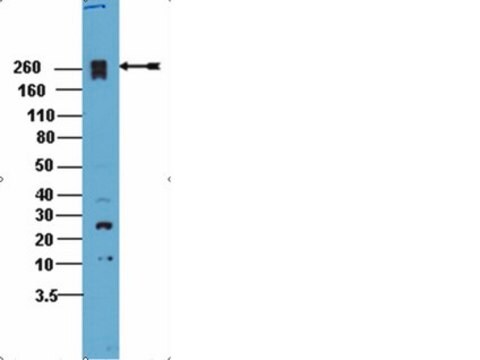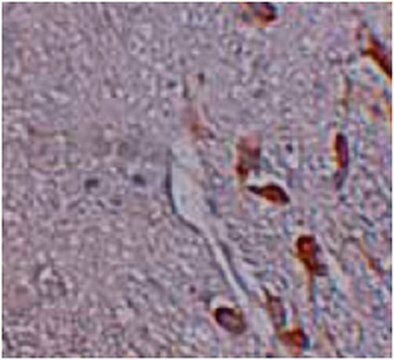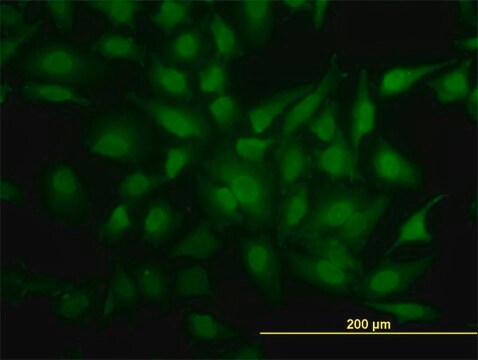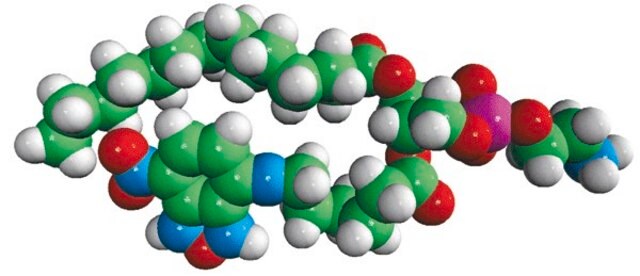Description générale
GTP cyclohydrolase 1 (UniProt: P30793; also known as EC: 3.5.4.16, GTP cyclohydrolase, GTP-CH-I) is encoded by the GCH1 (also known as DYT5, GCH) gene (Gene ID: 2643) in human. GTP-CH-1 is a functional enzyme that is involved in step 1 of the subpathway for synthesis of 7, 8-dihydroneopterin triphosphate from GTP. It is shown to positively regulate nitric oxide synthesis in umbilical vein endothelial cells. It is expressed in epidermis and its expression is high in basal undifferentiated keratinocytes. Four isoforms of GTP-CH-1 are reported that are produced by alternative splicing. Its activity is inhibited by tetrahydrobiopterin and GTP has a positive allosteric effect on its activity. It contains three zinc binding sites (aa 141, 144, 211) and Zn2+ is shown to be essential for its catalytic activity. Its activity is also up-regulated by IFN-gamma, TNF, interleukin-1 beta, bacterial lipopolysaccharides and phenylalanine, and is down-regulated by dibutyryl-cAMP, iloprost and 8-bromo-cGMP in HUVEC. Up-regulation of its activity stimulates the production of tetrahydrobiopterin that results in elevation of endothelial nitric oxide synthase activity. GTP-CH-1 is phosphorylated by casein kinase II at serine 81 in aortic endothelial cells during oscillatory shear stress that results in increased enzyme activity. Mutations in GCH1 gene can result in hyperphenylalaninemia and depletion of dopamine and serotonin resulting in psychomotor retardation, tonicity disorders, convulsions, and abnormal movements.
Spécificité
This rabbit polyclonal antibody detects GTP cyclohydrolase 1 in human cells. It targets an epitope within 15 amino acids from the N-terminal region.
Immunogène
Epitope: N-terminus
KLH-conjugated linear peptide corresponding to 15 amino acids from the N-terminal region of human GTP cyclohydrolase 1. The immunogen sequence is conserved in all four isoforms.
Application
Anti-GTP cyclohydrolase 1, Cat. No. ABS1488, is a rabbit polyclonal antibody that detectsGTP cyclohydrolase 1 and has been tested for use in Immunohistochemistry (Paraffin) and Western Blotting.
Immunohistochemistry Analysis: A 1:250-1,000 dilution from a representative lot detected GTP cyclohydrolase 1 in human vagina and human small intestine tissue sections.
Research Category
Signaling
Qualité
Evaluated by Western Blotting in human liver tissue lysate.
Western Blotting Analysis: 0.5 µg/mL of this antibody detected GTP cyclohydrolase 1 in 10 µg of human liver tissue lysate.
Description de la cible
~28 kDa observed; 27.90 kDa calculated. Uncharacterized bands may be observed in some lysate(s).
Forme physique
Affinity Purified
Purified rabbit polyclonal antibody in buffer containing 0.1 M Tris-Glycine (pH 7.4), 150 mM NaCl with 0.05% sodium azide.
Stockage et stabilité
Stable for 1 year at 2-8°C from date of receipt.
Autres remarques
Concentration: Please refer to lot specific datasheet.
Clause de non-responsabilité
Unless otherwise stated in our catalog or other company documentation accompanying the product(s), our products are intended for research use only and are not to be used for any other purpose, which includes but is not limited to, unauthorized commercial uses, in vitro diagnostic uses, ex vivo or in vivo therapeutic uses or any type of consumption or application to humans or animals.









